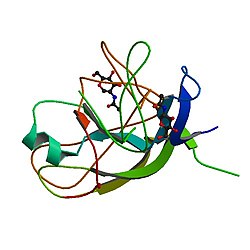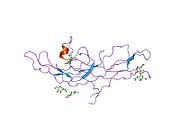Protein-coding gene in the species Homo sapiens
| CGB1 |
|---|
 |
| Identifiers |
|---|
| Aliases | CGB1, chorionic gonadotropin beta subunit 1, chorionic gonadotropin subunit beta 1 |
|---|
| External IDs | OMIM: 608823; MGI: 96782; HomoloGene: 137643; GeneCards: CGB1; OMA:CGB1 - orthologs |
|---|
| Gene location (Human) |
|---|
 | | Chr. | Chromosome 19 (human)[1] |
|---|
| | Band | 19q13.33 | Start | 49,035,569 bp[1] |
|---|
| End | 49,036,895 bp[1] |
|---|
|
| RNA expression pattern |
|---|
| Bgee | | Human | Mouse (ortholog) |
|---|
| Top expressed in | - testicle
- gonad
- body of pancreas
- muscle of thigh
- duodenum
- granulocyte
- stromal cell of endometrium
- right uterine tube
- fundus
- mucosa of transverse colon
|
| | | More reference expression data |
|
|---|
| BioGPS | |
|---|
|
| Gene ontology |
|---|
| Molecular function | | | Cellular component | - extracellular region
- extracellular space
- cytoplasm
| | Biological process | - G protein-coupled receptor signaling pathway
- cell-cell signaling
- hormone-mediated signaling pathway
- ovulation
- regulation of signaling receptor activity
| | Sources:Amigo / QuickGO |
|
| Orthologs |
|---|
| Species | Human | Mouse |
|---|
| Entrez | | |
|---|
| Ensembl | | |
|---|
| UniProt | | |
|---|
| RefSeq (mRNA) | | |
|---|
| RefSeq (protein) | | |
|---|
| Location (UCSC) | Chr 19: 49.04 – 49.04 Mb | n/a |
|---|
| PubMed search | [2] | [3] |
|---|
|
| Wikidata |
| View/Edit Human | View/Edit Mouse |
|
Choriogonadotropin subunit beta variant 1 is a protein that in humans is encoded by the CGB1 gene.[4][5]
The beta subunit of chorionic gonadotropin (CGB) is encoded by six highly homologous and structurally similar genes that are arranged in tandem and inverted pairs on chromosome 19q13.3, and contiguous with the luteinizing hormone beta (LHB) subunit gene. The CGB genes are primarily distinguished by differences in the 5' untranslated region. This gene was originally thought to be one of the two pseudogenes (CGB1 and CGB2) of CGB subunit, however, detection of CGB1 and CGB2 transcripts in vivo, and their presence on the polysomes, suggested that these transcripts are translated. To date, a protein product corresponding to CGB1 has not been isolated. The deduced sequence of the hypothetical protein of 132 aa does not share any similarity with that of functional CGB subunits (Dirnhofer S, Hermann M, Hittmair A, Hoermann R, Kapelari K, Berger P (December 1996). "Expression of the human chorionic gonadotropin-beta gene cluster in human pituitaries and alternate use of exon 1". J. Clin. Endocrinol. Metab. 81 (12): 4212–7. doi:10.1210/jcem.81.12.8954017. PMID 8954017.). However, a 155 aa protein, translated from a different frame, is about the same size, and shares 98% identity with other CGB subunits.[5]
References
- ^ a b c GRCh38: Ensembl release 89: ENSG00000267631 – Ensembl, May 2017
- ^ "Human PubMed Reference:". National Center for Biotechnology Information, U.S. National Library of Medicine.
- ^ "Mouse PubMed Reference:". National Center for Biotechnology Information, U.S. National Library of Medicine.
- ^ Policastro P, Ovitt CE, Hoshina M, Fukuoka H, Boothby MR, Boime I (Nov 1983). "The beta subunit of human chorionic gonadotropin is encoded by multiple genes". J Biol Chem. 258 (19): 11492–9. doi:10.1016/S0021-9258(17)44254-2. PMID 6194155.
- ^ a b "Entrez Gene: CGB1 chorionic gonadotropin, beta polypeptide 1".
Further reading
- Bo M, Boime I (1992). "Identification of the transcriptionally active genes of the chorionic gonadotropin beta gene cluster in vivo". J. Biol. Chem. 267 (5): 3179–84. doi:10.1016/S0021-9258(19)50712-8. PMID 1371113.
- Policastro PF, Daniels-McQueen S, Carle G, Boime I (1986). "A map of the hCG beta-LH beta gene cluster". J. Biol. Chem. 261 (13): 5907–16. doi:10.1016/S0021-9258(17)38469-7. PMID 2422163.
- Jameson JL, Lindell CM (1989). "Isolation and characterization of the human chorionic gonadotropin beta subunit (CG beta) gene cluster: regulation of transcriptionally active CG beta gene by cyclic AMP". Mol. Cell. Biol. 8 (12): 5100–7. doi:10.1128/MCB.8.12.5100. PMC 365611. PMID 2468994.
- Julier C, Weil D, Couillin P, et al. (1984). "The beta chorionic gonadotropin-beta luteinizing gene cluster maps to human chromosome 19". Hum. Genet. 67 (2): 174–7. doi:10.1007/BF00272995. PMID 6204923. S2CID 25631308.
- Talmadge K, Boorstein WR, Vamvakopoulos NC, et al. (1985). "Only three of the seven human chorionic gonadotropin beta subunit genes can be expressed in the placenta". Nucleic Acids Res. 12 (22): 8415–36. doi:10.1093/nar/12.22.8415. PMC 320381. PMID 6209613.
- Talmadge K, Boorstein WR, Fiddes JC (1984). "The human genome contains seven genes for the beta-subunit of chorionic gonadotropin but only one gene for the beta-subunit of luteinizing hormone". DNA. 2 (4): 281–9. doi:10.1089/dna.1983.2.281. PMID 6319099.
- Talmadge K, Vamvakopoulos NC, Fiddes JC (1984). "Evolution of the genes for the beta subunits of human chorionic gonadotropin and luteinizing hormone". Nature. 307 (5946): 37–40. Bibcode:1984Natur.307...37T. doi:10.1038/307037a0. PMID 6690982. S2CID 4282776.
- Dirnhofer S, Hermann M, Hittmair A, et al. (1997). "Expression of the human chorionic gonadotropin-beta gene cluster in human pituitaries and alternate use of exon 1". J. Clin. Endocrinol. Metab. 81 (12): 4212–7. doi:10.1210/jcem.81.12.8954017. PMID 8954017.
- Venter JC, Adams MD, Myers EW, et al. (2001). "The sequence of the human genome". Science. 291 (5507): 1304–51. Bibcode:2001Sci...291.1304V. doi:10.1126/science.1058040. PMID 11181995.
- Giovangrandi Y, Parfait B, Asheuer M, et al. (2001). "Analysis of the human CGB/LHB gene cluster in breast tumors by real-time quantitative RT-PCR assays". Cancer Lett. 168 (1): 93–100. doi:10.1016/S0304-3835(01)00496-7. PMID 11368883.
- Strausberg RL, Feingold EA, Grouse LH, et al. (2003). "Generation and initial analysis of more than 15,000 full-length human and mouse cDNA sequences". Proc. Natl. Acad. Sci. U.S.A. 99 (26): 16899–903. Bibcode:2002PNAS...9916899M. doi:10.1073/pnas.242603899. PMC 139241. PMID 12477932.
- Hallast P, Rull K, Laan M (2007). "The evolution and genomic landscape of CGB1 and CGB2 genes". Mol. Cell. Endocrinol. 260–262 (9): 2–11. doi:10.1016/j.mce.2005.11.049. PMC 2599907. PMID 17055150.
External links
PDB gallery
-
1hcn: STRUCTURE OF HUMAN CHORIONIC GONADOTROPIN AT 2.6 ANGSTROMS RESOLUTION FROM MAD ANALYSIS OF THE SELENOMETHIONYL PROTEIN -
1hrp: CRYSTAL STRUCTURE OF HUMAN CHORIONIC GONADOTROPIN -
1qfw: TERNARY COMPLEX OF HUMAN CHORIONIC GONADOTROPIN WITH FV ANTI ALPHA SUBUNIT AND FV ANTI BETA SUBUNIT |
 | This article on a gene on human chromosome 19 is a stub. You can help Wikipedia by expanding it. |

 1hcn: STRUCTURE OF HUMAN CHORIONIC GONADOTROPIN AT 2.6 ANGSTROMS RESOLUTION FROM MAD ANALYSIS OF THE SELENOMETHIONYL PROTEIN
1hcn: STRUCTURE OF HUMAN CHORIONIC GONADOTROPIN AT 2.6 ANGSTROMS RESOLUTION FROM MAD ANALYSIS OF THE SELENOMETHIONYL PROTEIN 1hrp: CRYSTAL STRUCTURE OF HUMAN CHORIONIC GONADOTROPIN
1hrp: CRYSTAL STRUCTURE OF HUMAN CHORIONIC GONADOTROPIN 1qfw: TERNARY COMPLEX OF HUMAN CHORIONIC GONADOTROPIN WITH FV ANTI ALPHA SUBUNIT AND FV ANTI BETA SUBUNIT
1qfw: TERNARY COMPLEX OF HUMAN CHORIONIC GONADOTROPIN WITH FV ANTI ALPHA SUBUNIT AND FV ANTI BETA SUBUNIT

















